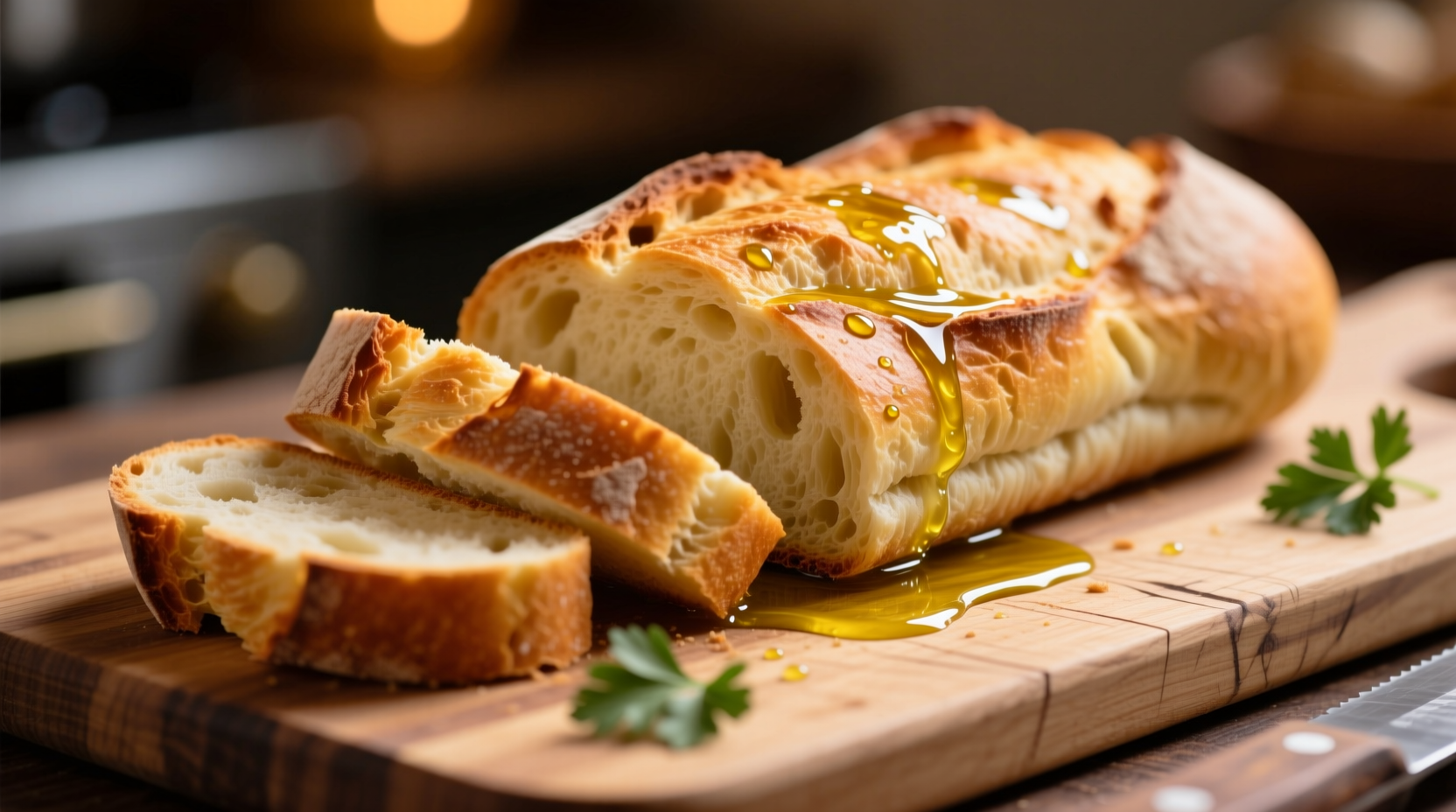The perfect garlic bread with olive oil uses high-quality extra virgin olive oil, fresh garlic, and crusty bread. Olive oil creates a crispier texture with more nuanced garlic flavor compared to butter, while offering health benefits. The key is using the right oil-to-garlic ratio and proper bread selection—details we'll explore in this comprehensive guide.
Why Olive Oil Makes Superior Garlic Bread
While traditional garlic bread often uses butter, olive oil provides distinct advantages that professional chefs have embraced. The science behind this preference lies in fat chemistry and flavor interaction. Olive oil's monounsaturated fats have a higher smoke point than butter's saturated fats, allowing for better browning without burning garlic. According to research from the National Center for Biotechnology Information, olive oil preserves more of garlic's beneficial compounds during cooking compared to dairy fats.
| Characteristic | Olive Oil | Butter |
|---|---|---|
| Smoke Point | 375-410°F (extra virgin) | 302°F |
| Flavor Profile | Grassy, peppery notes enhance garlic | Dairy notes compete with garlic |
| Crispness Duration | Maintains crispness for 20+ minutes | Crispness fades within 10 minutes |
| Health Profile | Heart-healthy monounsaturated fats | Saturated fats |
The Evolution of Garlic Bread Preparation
Garlic bread's journey reflects Mediterranean culinary evolution. While garlic-rubbed bread dates back to ancient Rome, the modern version emerged in 20th century Italy. Traditional Italian 'bruschetta al aglio' used only olive oil and garlic on toasted bread. Americanized versions with butter became popular in the 1950s-60s as Italian-American cuisine developed. Recent culinary trends have returned to the original olive oil preparation, with chefs recognizing its superior flavor and texture properties for authentic preparation.
Selecting Your Ingredients for Perfect Results
Choosing the right olive oil makes or breaks your garlic bread. Extra virgin olive oil provides the best flavor but has a lower smoke point. For baking, consider using a blend of 75% mild extra virgin and 25% regular olive oil. Avoid 'light' or refined olive oils—they lack the flavor complexity needed. The International Olive Council confirms that authentic extra virgin olive oil contains higher levels of polyphenols that complement garlic's flavor profile.
Garlic selection matters more than many realize. Fresh, firm cloves with tight skin provide the best flavor. Avoid pre-minced garlic in jars—studies from the Oregon State University Extension Service show it loses up to 60% of its beneficial compounds within hours of preparation. For optimal flavor release, mince garlic finely and let it rest for 10 minutes before mixing with oil.
Bread selection is equally critical. Choose a crusty artisan loaf with an open crumb structure—ciabatta, baguette, or rustic sourdough work best. The bread should have a firm crust that can withstand oil without becoming soggy. Avoid soft sandwich breads, which lack the necessary structure for proper garlic bread preparation.

Step-by-Step Preparation Guide
Preparation ratio: Use 3 tablespoons of olive oil per 3-4 garlic cloves for a standard baguette. This garlic bread olive oil ratio ensures flavorful but not overpowering results. Too little garlic creates bland bread; too much can become bitter when heated.
Technique matters: Never apply raw garlic directly to bread before baking—that creates harsh, acrid flavors. Instead, combine minced garlic with olive oil and let it infuse for 10-15 minutes at room temperature. This allows the alliinase enzyme in garlic to activate properly, creating the desirable flavor compounds without bitterness.
Baking process: Preheat oven to 375°F (190°C). Slice bread but don't cut all the way through—create a accordion-style loaf. Mix garlic and oil, then carefully spread between slices. Wrap loosely in foil for the first 10 minutes, then remove foil for final 5-7 minutes to achieve perfect crispness. This garlic bread with olive oil baking technique prevents burning while ensuring even flavor distribution.
When Olive Oil Works Best (and When It Doesn't)
Olive oil excels for traditional Italian-style garlic bread, particularly with rustic, crusty breads. It's ideal when serving with tomato-based dishes, as the flavors complement each other. Olive oil preparation also works better for health-conscious meals or when you want the pure garlic flavor to shine through.
Butter remains preferable for softer, pull-apart garlic bread styles or when creating a richer, more indulgent side dish. For cheese-topped variations, a blend of half olive oil and half butter often provides the best texture and flavor balance. Understanding these context boundaries ensures you select the right fat for your specific garlic bread application.
Common Mistakes to Avoid
Using old garlic: Sprouted or soft garlic develops unpleasant flavors. Always use fresh, firm cloves for the best garlic olive oil bread results.
High oven temperature: Baking above 400°F causes garlic to burn before bread crisps properly. Stick to 375°F for optimal results.
Skipping the resting period: Applying oil immediately after mincing garlic misses the crucial enzymatic reaction that develops flavor. Allow 10 minutes for proper flavor development in your olive oil garlic bread.
Storage and Reheating Tips
Store leftover garlic bread in an airtight container at room temperature for up to 24 hours. For longer storage, freeze slices on a baking sheet, then transfer to freezer bags. Reheat in a 350°F oven for 5-7 minutes—never use a microwave, which creates soggy texture. Properly stored olive oil garlic bread maintains quality better than butter versions due to the oil's stability.











 浙公网安备
33010002000092号
浙公网安备
33010002000092号 浙B2-20120091-4
浙B2-20120091-4